
What is job satisfaction?
The term job satisfaction, also known as employee satisfaction, is used in organizations to understand the state of an employee’s happiness or unhappiness in their job.
Nadi (1997) defined job satisfaction as composed of the reaction, attitude, or perception of an individual to work.
Managers may ask questions to understand job satisfaction, like:
- How satisfied are you with your job? (with the answer range including these answers: Completely satisfied, somewhat satisfied, somewhat dissatisfied, completely dissatisfied, no opinion)
- Are you happy with your annual pay? (yes/no)
- Do you find your workplace conditions supportive of your career development? (yes/no)
- Do you have a good work-life balance? (yes/no)
These kinds of questions help determine the level of job satisfaction and if the employee’s job is matching up to their expectations. They give a useful indicative measure of the job satisfaction situation at one moment in time.
This can be useful to know because job satisfaction is a key reason why employees may stay in a company long-term. Satisfied employees are less likely to leave, meaning attrition rates remain low.
This has knock-on effects for the company – with high job satisfaction, companies can keep hold of vital business knowledge, productivity is not interrupted by the need to recruit for replacement employees, and team morale is kept intact.
Yet, job satisfaction as a measure is dependent on many factors, and this isn’t captured by the questions above. A better measurement to consider is employee engagement, which is part of the overall employee experience.
Free ebook: How to design an employee engagement survey
Employee satisfaction vs employee engagement
While job/employee satisfaction and employee engagement sound like the same thing, they are different:
Job/employee satisfaction – an employee may be perfectly satisfied with their job because it pays their bills, maintains the status quo, and fits their lifestyle. Some satisfied employees do the bare minimum required to keep their jobs. They are not necessarily motivated by the development and success of the company as a whole.
Employee engagement – runs deeper; an engaged employee is usually also a satisfied employee, but they have passion, commitment, and a desire to ‘go the extra mile’ to make the company a success. Engaged employees thrive on challenge, purpose, and meaningful work.
Measure your employees' satisfaction with our free Employee Satisfaction template
What has employee experience got to do with job satisfaction?
From the moment someone looks at your job opening, to the moment they leave your company, everything that the worker learns, does, sees, and feels contributes to their employee experience.
For your organization to master employee experience management, you must listen to your people at each stage of the employee lifecycle, identify what matters most to them, and create personalized, bespoke experiences.
It takes into consideration:
- How well onboarding activities occur
- If employees are provided with the right support and training
- If employees are listened to and valued
- Their day-to-day engagement with staff relationships and their environment
- Their role within the company and how included they feel
- How relevant issues and improvements are handled
- Their exit process and the reasons leading up to it
Edwin A. Locke (2016) defines job satisfaction by the following job satisfaction factors:
- Work
- Love of the activity, personal interest
- Love of achievement (meeting standards of excellence)
[NOTE: the above two have been confounded as “intrinsic motivation”. This is a serious error – the two are not the same – you can like doing something without trying to be an expert at it and you can work to be good at something that you do not greatly enjoy)
- Mental challenge, engaging your mind, growing, learning new things. Without this,growt you get bored—control over key aspects of the work
- Belief that the work is in some way important
- Pay
- Pay is set by a fair method or procedure (procedural justice)
- Amount of pay is fair (distributive justice)
- Pay is high (almost no one thinks they are paid too much and most would like more)
- Promotions: opportunity for advancement, growth; fair process (for those with ambition)
- Peers, colleagues
- Nice to work with, cooperative, considerate
- Honest
- Competent: can do their jobs well
- Supervisor (if have one)
- Can trust their competence, their integrity, and their goodwill
- Make clear what your job goals are
- Give fair recognition, credit, praise
- Considerate, respectful
- Top Leadership
- Competent: can put the pieces together so that the organization succeeds
- Honest
- Benefits & policies
- Competitive with similar organizations
- The more the better (there is no limit to what might be offered)
- Healthy, safe working conditions
Job satisfaction statistics for US employee job satisfaction
If we look at job satisfaction statistics over a number of years, they tell us an interesting story.
In the US, job satisfaction levels in 2020 reached a 20-year high, despite market conditions being affected by the pandemic over recent years.
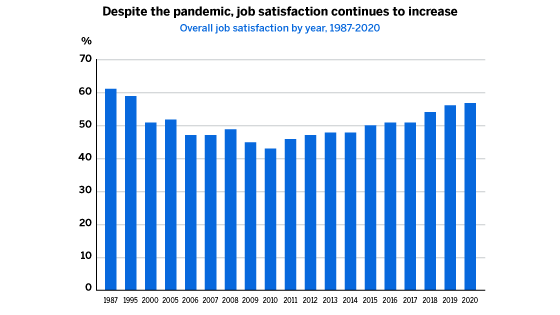
Though when we break down total satisfaction into different levels of job satisfaction, we can see a worrying fact emerge: The percentage of people that are completely dissatisfied with their job is increasing (5% in 2021 from 1% in 2017). This is also true for people who are somewhat dissatisfied with their job (9% in 2021 from 6% in 2017).
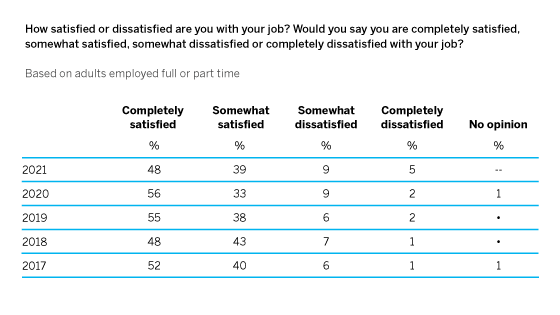
Decreases in job satisfaction can be down to traditional culprits like decreases in job security, pay, benefits (bonuses and pensions), and training budgets.
However, as the pandemic highlighted the impact on mental health and the dangers of interacting at work, increased amounts of flexible time, working at home, and mental health support directly related to better job satisfaction rates, sense of self, and improved working conditions.
58% of American employees found a good company culture is one of the must-have features.
Why is job satisfaction important?
For the employees, work plays an important role in helping employees find meaning in their lives:
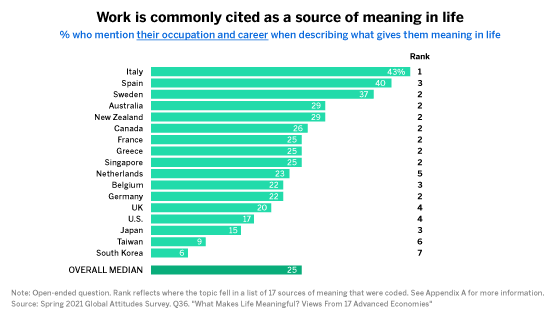
This supports the 2019 Workplace Happiness Report by Udemy, which found that 37% of employees confirmed that work-life balance added meaning to the job satisfaction level.
A job can also be a primary source of satisfaction in their lives:
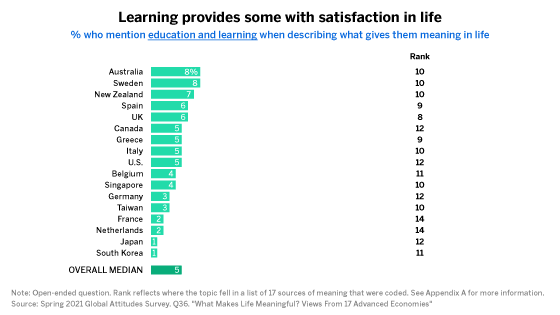
61% of workers think trust between them and the management leads to higher job satisfaction.
For the organization, there are four benefits to improving job satisfaction levels:
- Increased profits: Higher satisfaction can directly lead to 21% greater profitability as there is more drive that leads to more sales.
- Higher productivity: Employees that are happier are more motivated and engaged, which can lead to 41% reduction in absenteeism
- Lower turnover: Happier and satisfied employees can result in 59% less attrition as they are less likely to leave.
- Loyalty: If employees believe they are supported, they want to share their job satisfaction and can become strong brand ambassadors. They can tell friends and family about the company, as well as shine a positive light about the brand in conversations with customers.
How can you drive job satisfaction in your business?
With so many reasons to improve job satisfaction, it can be hard to know how to bring it together. So far, we have learned in the article that job satisfaction is important to know whether the employee’s job is matching up to their expectations.
We have also understood that remedial work around job satisfaction can be better completed by companies that consider it in light of the whole employee’s experience. This gives us an ongoing process where continuous improvement can be made in lots of areas that keep employees happy.
Go beyond job satisfaction
We’ve developed and validated a more modern view of employee experience, which makes employee experience easier to understand and act on. (As job satisfaction is a key factor to determine total employee experience, it’s worth seeing it in context.)
Our in-house team of organizational psychologists identified 5 key KPIs to measure EX:
- Experience: The relationship and support from the manager
- Intent to Stay: The company culture that attracts people to stay
- Engagement: How engaged the employees find their roles
- Inclusion: How involved and included they felt in their teams
- Well-being: How does the company encourage employees to focus on their health
And there are 25 drivers that influence them, which come together as a framework called EX25, an industry-leading holistic approach to measuring and optimizing employee experience:
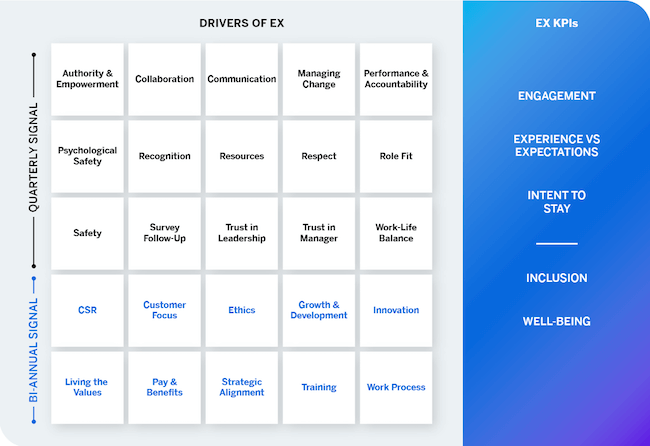
With EX25, management can holistically understand employee experience and where to focus and lead employees in order to drive impact.
Learn more about EX25 and how this works by reading our EX25 article.
Use the right technology
Manually setting up and running meetings to discuss your people’s experiences with each of your employees is valuable but time-consuming. Collating this primary first-hand information will also make it hard to analyze without the right technology platform that is intelligent enough to understand text analysis and sentiments.
A way to gain more information on job satisfaction at a wider scale, faster, and for easy interpretation is to use an employee experience engagement program. Our engagement software platform makes it easy to pinpoint EX25 drivers, so you can act in real-time to:
- Improve employee engagement across the organization
- Act quickly on real-time data to address problems
- See how your actions impact employee productivity and organizational KPIs
- Enable managers with data and action planning
- Reduce unwanted and costly attrition
Use our free employee satisfaction survey template to help employers find out about the employee experience, directly from employees themselves. The questions have been created by our subject matter experts and in-house organizational psychologists. You can find out how to use an employee job satisfaction survey by reading this blog with hints and tips.
Build an internal culture to support your focus on employee experience
- Use available data to understand what your culture is currently like: You can start to identify metrics with your human resources team as they are most connected with employees’ life cycle stages (onboarding, exit, and on-job activities). Secondary data like hiring and attrition statistics can be collected and analyzed, so you can create a better target value to aim for.
- Start a conversation about career development: If we know that employees want to find meaning and job satisfaction, ensure your roles are challenging. Offering a training plan to support your employee could keep them invested in the role and enhance the skill levels available to the company.
- Boost your work-life balance and job security awareness: If you haven’t shared your positive news with your employees, now’s the time to do it. You can set up a free channel via slack, email, or newsletter to make internal communications about the wellness benefits and commitment to employee experience and job satisfaction.
- Encourage diversity, equality, and inclusion across the whole company: If a company feels inclusive, and shows this in every department and in their actions – positive conversations, fair treatment, openness, and accountability – this can help employees feel safe working in an organization and increase their job satisfaction.
3 examples of companies that got job satisfaction and employee satisfaction right
Netflix
Netflix’s core value statement about its employee experience culture is ‘people over process.’ Netflix is very much a people company, with a culture of great benefits aimed at supporting an employee’s work-life balance and supporting their health and well-being. These are appreciated by staff, with people reviewing these highly on Glass door:
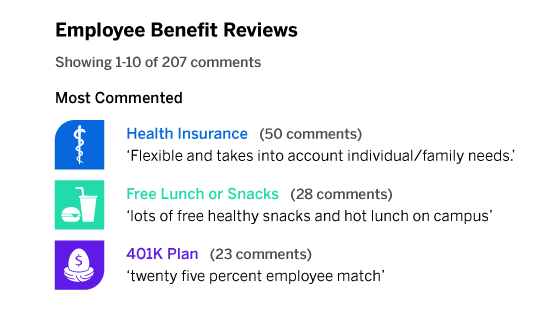
One of the key aims of CEO Reed Hastings was to build a company around freedom and responsibility, as shown in the video below. He did this as he believed that this is the ideal scenario for innovation to occur.
https://www.youtube.com/watch?v=pl4UYZfVmTA
According to the Great Place to Work 2019 U.S. National Employee Engagement Study, 97% of employees at Google Inc. said it is a great place to work compared to 59% of employees at a typical U.S.-based company.
This is a fantastic statistic, which arises due to Google’s fierce focus on keeping their employees happy, well-compensated, and supported. At work, employees have access to free meals, gym, laundry, relaxation pods, and on-site childcare. In addition, Google provides paid parental leave.
Business Insider Australia found that Google employees viewed working at Google as a moral rather than a business goal, which motivated them to innovate and push into new areas.
Apple
Apple is another company that has got its job satisfaction balance right. They too offer great benefits to keep their employees content - great compensation, discounted technology products and services, fitness and wellbeing benefits.
In addition, the secret comes down to a strong culture around a strong vision and mission. Senior Vice President of Retail and Online Stores, Angela Ahrendts, said “That foundation, that service mentality, that drive to continue to change lives – that is a core value in the company. And Tim [Cook] then has added this on: He says it’s also our responsibility to leave it better than we found it. So you have these two amazing pillars and a culture built around that.”
Find out more
For more information about how you improve your job satisfaction discover how to get to the bottom line by starting with your employees. The most effective manner to measure employee engagement/satisfaction is by asking them through comprehensive surveys.
The Essential Guide to Employee Experience Surveys